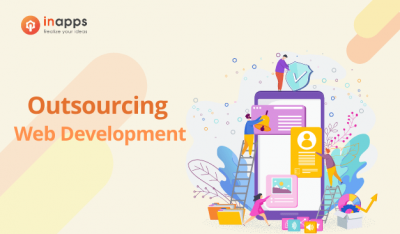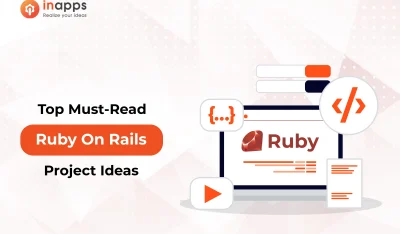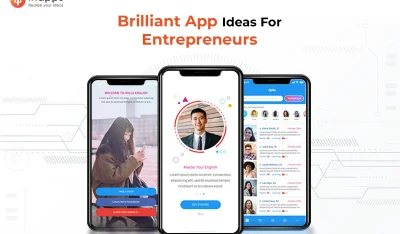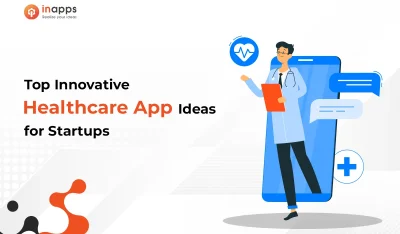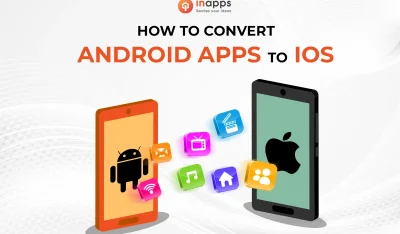- Home
- >
- Mobile apps development
- >
- Most Popular React-Native Apps Examples To Inspire You
React-Native apps have become more popular. A lot of people were unhappy with how slow traditional native apps were to load and the lag people experienced with them. React Native has emerged as a frontrunner in addressing these challenges. In this article, we delve into the top 10 examples of React Native apps, showcasing some of the most successful apps built with this framework., what they offer, and why they’ve been so successful.
What is React Native?
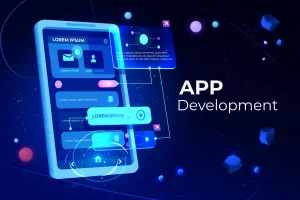
React Native is an open-source framework developed by Facebook. It is used to make apps for Android, Android TV, iOS, macOS, tvOS, Windows, and UWP by enabling developers to use React along with native platform capabilities.
React-native components are side-effect-free functions, that return what the views look like at any point in time. Hence, it is simpler to create state-dependent views, as there is no need to worry about updating the view when the state changes.
There are many different ways to create a mobile app – from coding a native one to using a structured framework like React-native. In today’s world, where the most convenient way to get information is through your phone, you need your app to be cross-platform and work with different operating systems.
Why big companies are using React-native apps
React Native brought more power to Mobile App Development Technology, which was specially designed by Facebook for developing native applications for portals like Android & iOS. Because of the ease of reusing most of the code across various platforms, react-native accelerates the process of building apps and is the preferred technology by developers all over the globe. So, if you considering building new apps for your business, go for react-native apps, as it enables us to create native applications in JavaScript for both Android & iOS.
Furthermore, it provides us with the capacity to access all the native components like gestures, cameras, push notifications, and location. React Native is a flexible and innovative framework that’s been getting a lot of attention lately because it allows for native mobile development, which is a huge benefit to both developers and end-users.
Now, let’s discuss some of the most popular examples of react-native apps and learn why they were chosen.
Most Popular React-Native Apps Examples
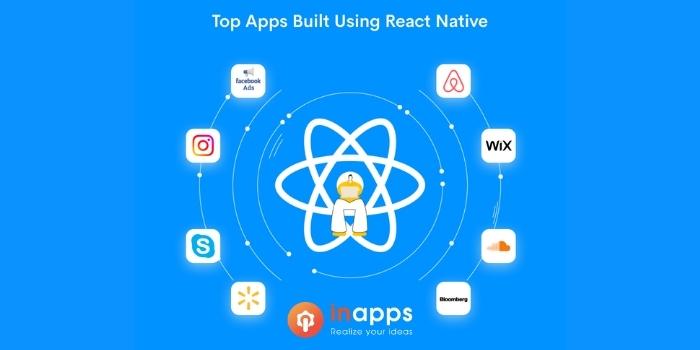
1. Facebook – the most reactive native apps
React Native, initially developed as a hackathon project within Facebook, has transformed the way Facebook approached web development. This innovation came from Facebook’s need to streamline its internal app development process and address various challenges effectively.
Originally, React-Native was developed to support iOS, and today it has swiftly extended its support to the Android operating system as well. Since this Javascript library can provide mobile UIs for both platforms, it is an obvious choice to build react-native apps for Facebook and its other similar verticals requiring app services.
Facebook made use of React Native to create its own Ads Manager app, developing both an iOS and an Android version by all of the same people. Also, they made it open-source with the thought to make it more compatible with other portals like Windows or tvOS.
Benefits of Building React-Native Apps
All improvements were done at the framework level to ensure better performance, now events dashboard startup is much faster with a new react-native app.

React Native’s architecture allows for real-time updates and hot reloading. Now changes can be made on the fly without compromising the app’s performance. This not only speeds up the development process but also ensures a smoother, more responsive user experience.
Moreover, the choice of React Native aligns with Facebook’s commitment to creating seamless, high-quality user interfaces. By leveraging React Native, Facebook was able to maintain a consistent look and feel across different platforms. At the same time, they can ensure that the app feels intuitive and native to each user, regardless of their device. This consistency in user experience is crucial for a company like Facebook, which has a diverse and global user base.
2. Facebook Ads
From a design perspective, React Native offered Facebook Ads a clean and intuitive user interface (UI) with an engaging user experience (UX). The framework enabled the app to feature smooth animations and transitions, making the interface easy to navigate and interact with.
Benefits of Building a React-Native App
The primary benefit of this React-Native App is lightning-fast speed, regardless of the kind of operations you want to perform. From tracking the present status of an in-progress campaign to creating a new one, it just requires 2 or more seconds to navigate to the next level with simplicity.
React Native’s ability to reuse code for both Android and iOS platforms saved significant time and resources in the app’s development. React Native apps, including Facebook Ads, run on native UI components of each platform, providing a seamless and consistent user experience. Plus, the modular and component-based nature of React Native apps makes them easy to scale and maintain.

3. Walmart
Walmart, in its pursuit to become the world’s largest online retailer, has always strived for innovation and technological advancement. This drive led them to integrate Node.js into their stack. But a few years later, they revamped their mobile app using React Native. The transition to React Native brought noticeable efficiency improvements in the app on both iOS and Android platforms, utilizing fewer resources and achieving better performance within a limited timeframe.
Why did Walmart choose React Native?
Walmart’s targets are high, always looking to become the world’s biggest online retailer. To meet these challenges, the firm should make explicit moves that may have a huge risk to gain a competitive edge. So, to improve user experience, they are always trying newer technologies, thus react-native seems like a natural choice.
The decision was also driven by several factors:
- Development Velocity: React Native enabled Walmart to double their development velocity. This acceleration was crucial for Walmart to quickly implement and test new features, keeping pace with the rapidly evolving retail market.
- Code Reusability: With React Native, Walmart’s development team could share about 95% of the codebase between Android and iOS, significantly reducing the time and effort required for cross-platform development.
- Hybrid App Approach: Walmart opted for a hybrid app model, leveraging the best of both native and React. This approach allowed them to integrate React Native components gradually into their existing app structure, ensuring stability and performance while transitioning
Benefits of building a react-native app
The switch to React Native resulted in a significant performance boost for Walmart’s app. It loaded faster, offered better navigation, and provided a more seamless user experience for users across both platforms. The initial hybrid approach using a mix of native and web-based components led to a subpar user experience. React Native addressed these issues, leading to an interface that was not only faster but also less cluttered and more intuitive.
By using native navigation instead of the React Native navigation system, Walmart could integrate new pages within the existing stack of views. This facilitated A/B testing and allowed for the occasional disabling of React Native pages to resolve issues. The ability to rapidly test and adjust features was crucial for Walmart in optimizing its app’s user experience.

4. Bloomberg
This react-native app provides a seamless, interactive journey with easily accessible customized content, videos, and live feeds displayed across Bloomberg’s Media.
reWhy React Native?
React native automates code refreshes, speeding up the launch of new product features. Rather than recompiling, your app reloads quickly. Plus, React Native enabled Bloomberg’s software engineers to develop a modern, streamlined UX design for the mobile app. This design approach allowed the delivery of personalized, continuously updated content, including recorded and live video feeds, in a way that was both efficient and engaging for users.
React Native supported Bloomberg in creating a flexible codebase that enabled seamless development on both iOS and Android, while also allowing for the writing of native code. This approach halved the usual development time, significantly boosting efficiency.
The nature of the React Native codebase also allows for more automated and frequent code refreshes. This capability was crucial for Bloomberg, as it enabled their engineers to make regular iterations and updates quickly and efficiently. All this ensures the app remains fresh and performs smoothly

5. Instagram
Instagram, a prominent photo and video-sharing social network, incorporated React Native into its existing native application to enhance its user experience. The initiative began with the implementation of the Push Notification view as a WebView, which was an entry point for integrating React Native.
Why React Native?
The dev team encountered a few issues here and there, but they gradually enhanced the developer’s velocity. 85% to 99% of code was shared between Android and iOS apps. Therefore, the team delivered the application way ahead of its time in comparison to a native solution. This code reuse capability led to faster development cycles, enabling Instagram to deliver applications much more quickly compared to a native solution. Tools like Live Reload and Hot Reloading eliminated the need for compile-install cycles, further accelerating the development process.
The framework’s ability to upload the JavaScript package into JavaScriptCore and instantiate native modules and view managers significantly enhanced the efficiency of the application. Instagram’s transition from the original Edit Profile view to React Native served as a starting point for this improvement.
The Core Client Team at Instagram implemented features such as Push Notification Settings, Edit Profile Views, and Photos of View using React Native. This Quick Feature Shipping adoption led to enhanced performance and was subsequently followed by most product teams within Instagram.
Instagram addressed the sluggish start and non-native feel of WebViews by transitioning functionalities like Post Promote to React Native. This shift resulted in significant improvements in startup times and the user interface

6. SoundCloud Pulse
SoundCloud Pulse is an app designed for creators to manage their accounts and engage with their community. It faced challenges during the development of its second set of native apps for Android and iOS. The initial focus was on iOS, where most of the creators were active, but they encountered difficulties in finding iOS engineers and ensuring a simultaneous release for both platforms. This led to the exploration of React Native, with the design team running user-testing sessions with React Native-based prototypes and leveraging the skills of eager web engineers
Why React- Native?
SoundCloud’s decision to utilize React Native for their Pulse app was primarily driven by the need for rapid prototyping and development speed. This approach allowed the team to quickly flesh out most screens of the app within the initial two-week prototype phase.
Transitioning to this technology also facilitated a unique collaborative environment. Particularly, the synergy between iOS and JavaScript engineers led to significant knowledge exchange and the completion of app screens at an impressive pace. This collaboration was crucial in maintaining the momentum gained during the early stages of development.
Moreover, React Native’s efficiency significantly expedited the overall development timeline. What was initially estimated as a six-month project was completed in just four months. This highlights React native’s ability to streamline any app development process.
Another pivotal factor in choosing React Native was its seamless integration with existing Objective-C libraries. This compatibility was beneficial for teams with a rich history in iOS development, allowing them to leverage their existing assets effectively and ensuring a smooth transition in the development process.
Finally, the cross-platform nature of React Native, which enabled about 85% code reuse between iOS and Android, significantly reduced the additional effort and cost involved in developing new features for both platforms. The ability to update the application on the fly allowed for immediate bug fixes and updates. This flexibility in updating and maintaining the app was a significant advantage in the fast-paced world of mobile app development.

7. Townske
The final UI is extremely responsive and feels fluid due to asynchronous JavaScript interactions with the native environment. This implies that the app will load more quickly and smoothly than a typical hybrid app with a smoother feel.
Furthermore, the Townske development team, comprising a web developer and a designer, managed to complete the first version of the app in just two months. This efficiency is particularly notable considering they were using an early version of React Native. The team also appreciated features like live-reload and CodePush, and they were able to make a significant portion of the business logic sharable between the web and React Native platforms.
This approach streamlined the development process and ensured a consistent user experience across different platforms

8. Gyroscope
This wide range of functionalities showcases the flexibility and robustness of React Native as a development platform
Benefits of Building a React-Native App
Most of the data is exhibited in 2 beautiful, well-structured views- easy and card mode. All monitored information is aggregated in daily/weekly/monthly statements, and you can simply look into it and select whatever you want to give attention to next.
React Native’s component-based architecture enables the creation of a rich, intuitive user interface. This is crucial for Gyroscope, which requires a clean and engaging display to present complex health data. The framework allows for the implementation of multiple viewing modes, like Gyroscope’s ‘easy’ and ‘card’ modes, enhancing user experience and engagement.
Plus, React Native excels in handling large volumes of data efficiently, a necessity for Gyroscope’s extensive health tracking features. The framework facilitates smooth data aggregation and presentation, enabling users to easily access and interpret their health information in daily, weekly, or monthly reports. This efficient data management ensures the app remains responsive and user-friendly, even with substantial data processing.

9. Wix
React-native apps give many navigation choices for managing navigations, like- React-native-router-flux, react-navigation, Airbnb-native-navigation, and Wix-react-native-navigation. React-native navigation is preferred because of its highly configurable navigation and screen options along with appropriately managed and updated codebase.
Why React-Native?
For Wix’s specific case, the key factors that make React Native a valuable choice are Consistent User Experience Across Platforms andRapid Development, and Deployment.
To explain further, React Native allows developers to share a common codebase across iOS and Android. This sharing ensures that Wix can provide a uniform user experience on different mobile devices. This consistency is crucial for Wix’s diverse user base, who expect a seamless and intuitive experience regardless of their device.
React Native enhances Wix’s agility in developing and updating its mobile app offerings. The framework’s efficient development process, leveraging reusable components and hot reloading, allows Wix to implement new features and updates faster, keeping pace with changing user needs and technological advancements.
All in all, these factors align well with Wix’s commitment to providing accessible, high-quality web and mobile solutions to a broad range of users.

10. Delivery.com
Why React-Native?
React Native enables you to connect the plugin with a native component, so you can link the map with the device’s operations like rotate, zoom, and the compass while utilizing less memory and loading faster.
If your app has old operating systems (and older devices), this can allow your application to run smoothly.

React-Native Apps Examples: FAQs
List some React Native apps.
Some of the best and well known React Native apps are:
1. Instagram.
2. Skype.
3. Uber Eats.
4. Walmart.
5. Tesla.
6. Facebook Ads.
7. Wix.
8. Bloomberg.
How can React Native apps be helpful?
React Native allows us to write native apps in JavaScript for both iOS and Android. It gives us the ability to use all the native components like gestures, push notifications, camera, and location.
Learn more: Implement CodePush in React Native App – Simple Tutorial
In Conclusion
If you are thinking about developing mobile applications, then React-Native is the best choice to build your apps. React- Native apps are strong, efficient, modern technology that assists companies worldwide in approaching new customers on mobile platforms. They are fast, effective, and relatively easy to learn for JavaScript developers.
And, if you think we can help you with customizing react-native apps for your business, feel free to reach us. We look forward to hearing from you!
Let’s create the next big thing together!
Coming together is a beginning. Keeping together is progress. Working together is success.








